
|
|
Man's First Powered Flight Richard Pearse, Waitohi, New Zealand, March 31, 1902 A Tribute by Bill Sherwood Please note: This essay is reproduced here from the original in a format reworked to match the rest of this site. The original page was not compatible with earlier browsers as is required by the brief for this project. Other images have also been added (01/0002 Ed)
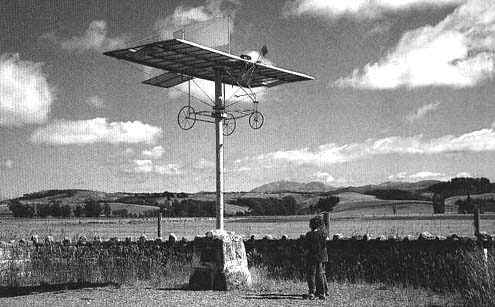
Monument to Richard Pearce at the site of his flights of 1902-1903 Download a closeup of the aircraft
Popular history has it that the Wright Brothers at Kitty Hawk [in the United States] were the first to fly [a heavier-than-air craft], but this is not true! The first flight was by a twenty-five year old New Zealander, Richard Pearse on March 31, 1902. Pearse, (1877 - 1953), is not generally known for this wonderful feat as [until recently?] there has been very little publicity about it. In fact the first formal mention of his achievement was some seven years later in the newspapers of 1909.
 Replica of Pearse's Machine at MOTAT in New Zealand
Pearse was an enthusiast, and perhaps a turn of the century 'mad scientist' inventor. Certainly his other creations - mostly farm machinery - were far from the mainstream and thus [ also ] didn't get much credit. But he did get a few things right on his flying machine that were amazingly advanced for the time. Accounts by witnesses of the flight vary, from "50 to 400 yards in length", but it seems most likely that it was around 350 yards long, and ending prematurely when the flying machine landed in a large hedge - 4 metres off the ground ! The aircraft was the first to use proper ailerons, instead of the inferior wing warping system that the Wright's used.
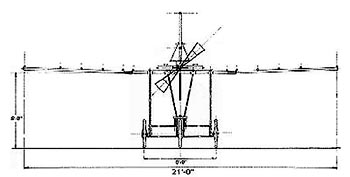 Front Elevation of Pearse's Machine
The flying machine also had a modern tricycle type landing gear, thus negating the need for ramps, slides, or skids. Any suitable road would do. The flying machine was aerodynamically crude, for sure, but did the job on the day, and in fact for months afterwards.
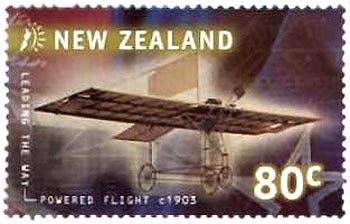 Postal Issue for the Centenary of Pearse's flight 1903-2003
By the end of July 1903, Pearse had achieved flights of around one kilometre in length, and perhaps even more amazingly, some of them included turns ! An absolutely fantastic achievement for the time. Pearce also built the engine, which was estimated at about 15 - 22hp, but hampered by a much cruder propeller than the Wright's machine.
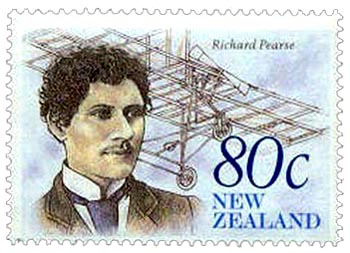 Postal Issue 1990
He didn't realise the historic importance of the event, and so didn't bother to have any photographs taken of his machine flying, though [as mentioned above], there is extensive evidence from witnesses describing his flights.
The FlightsMch 31, 1902 - First powered flight. Estimated distance around 350 yards. Similar to the first Wright Brothers flight, ie, in a straight line, and barely controlled. Mch ? 1903 - After spending a year working on the engine, and tending to his farm, Pearce made another flight, this time with a distance of only about 150 yards. May 2, 1903 - Distance unknown, but as usual the aircraft ended up stuck in a gorse hedge 15' off the ground! May 11, 1903 - This, my opinion, [ie. the opinion of Bill Sherwood] was man's first real flight. Pearse took off along the side of the Opihi River, turned left to fly over the 30' tall river bank, then turned right to fly parallel to the middle of the river. After flying nearly 1,000 yards, his engine began to overheat and lost power, thus forcing a landing way down the dry-ish riverbed. One of the locals, Arthur Tozer, was crossing the river at the time and was rather surprised to have Pearse fly right over his head!
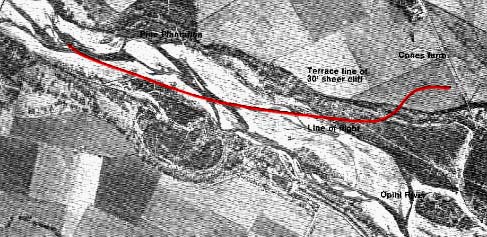 Aerial view of the Opihi River and Pearse's flight path
Bill Sherwood's article makes mention of and apologises for the poor quality of this image.
July 10, 1903 - Again, distance unknown, but the aircraft was (yet again!) stuck in a hedge many feet above the ground until the snow melted some time later. While these dates are as certain as they can be, is clear that Pearse flew many other times, perhaps as early as 1901. (Though this whilst being towed by two horses!) It is also believed that he also continued to make many other flights in the privacy of his own property, which as you may have guessed had some very large gorse hedges around it. His desire for privacy was no doubt a major restriction in his ability to find a clear area to fly for any great distance. The engine that he made was extremely clever, I [Bill Sherwood] think it was a twin cylinder and piston device, but the pistons worked in both directions so that it was effectively a four cylinder piston engine.
 Pearse's Engine Download a larger version - 136 k [ 1000 x 1500 pixels ]
Fairly soon afterwards Pearse lost interest in the fledgling aviation scene, as unfortunately all the credit was going to overseas flights. It was too late to claim the credit he was due, so he went back to farming. He made a brief return in the mid 1930's, when designed and partly built an aircraft that would have revolutionised air travel for the masses - It had fold up wings and tail so it could be put into a conventional garage. The engine could be run as either a 2 stroke or a 4 stroke, and also either supercharged or naturally aspirated. Also, the entire engine/prop assembly pivoted so that the aircraft could do a vertical takeoff and landing. It was never finished, for various reasons. Much of the information and pictures on this page is reproduced with the very kind permission [given to Bill Sherwood] of Geoffrey Rodliffe, author of the excellent book, Richard Pearse, Early new Zealand Pioneer Aviator. [Bill Sherwood also states] If you wish to know more of Pearse, please don't hesitate to purchase any of Geoffrey's books, or perhaps contact him via eMail at - Geoff.Rodliffe@clear.net.nz
New to this version
AvStop Magazine Online Research Wild and inaccurate statements have been publicised from time to time concerning Richard Pearse's achievements in the field of aviation. However. no responsible researcher has ever claimed that he achieved fully controlled flight before the Wright brothers, or indeed at any time. To attain fully controlled flight a pilot would have to be able to get his plane into the air, fly it on a chosen course and land it at a predetermined destination. Obviously Pearse's short "hops" or "flights", whilst they established the fact that he could readily become airborne, did not come within this category, but neither, for that matter, did the first powered flights of the Wright brothers in December 1903. The Wiight brothers, however, had the resources necessary to continue their experimentation until they achieved fully controlled flight. ...more
Further Reading
As a schoolboy, Richard Pearse was obsessed with the idea of flying. He is reported to have read everything he could find about flight and related subjects, to the detriment of his school work, and to have built models of planes and a string-pull helicopter. He wished to become an engineer, but his father insisted that he should take up farming, and gave him a farm at Waitohi, near Temuka, for his 21st birthday....more
First Man to 'Fly' a Mechanically Powered Aeroplane
NZine : Richard Pearse
Richard Pearse Aviation Pioneer
Richard Pearse Aviation Pioneer
Richard Pearse In Focus
|
© Copyright 1999-2002 CTIE - All Rights Reserved - Caution |